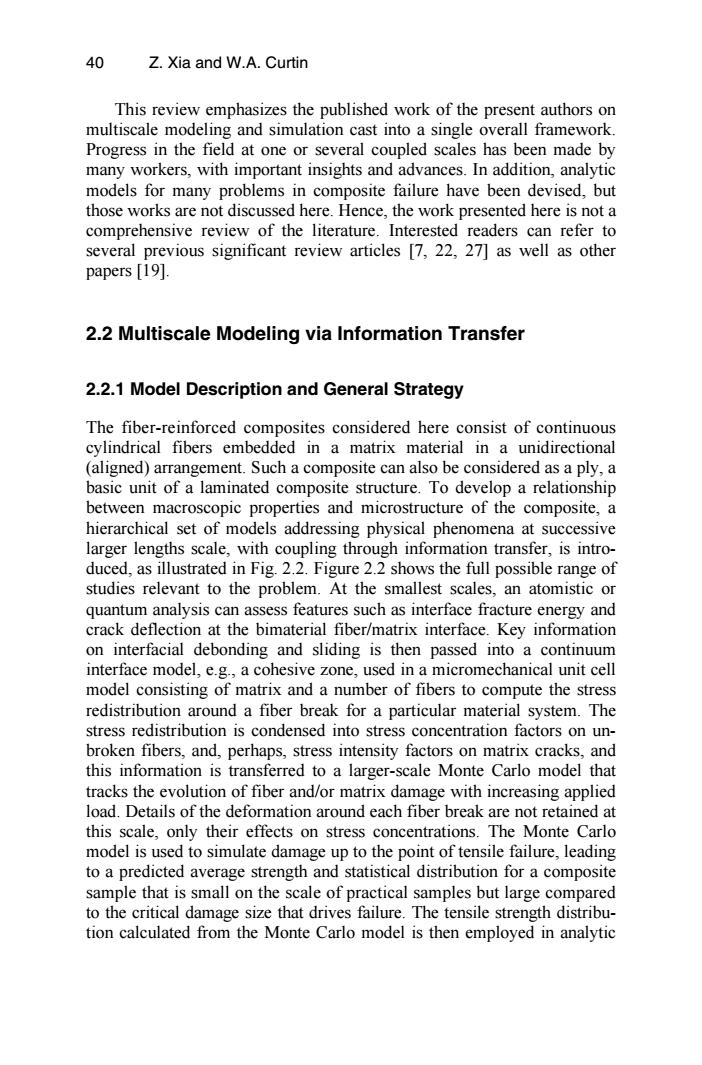正在加载图片...

40 Z.Xia and W.A.Curtin This review emphasizes the published work of the present authors on multiscale modeling and simulation cast into a single overall framework Progress in the field at one or several coupled scales has been made by many workers,with important insights and advances.In addition,analytic models for many problems in composite failure have been devised,but those works are not discussed here.Hence,the work presented here is not a comprehensive review of the literature.Interested readers can refer to several previous significant review articles [7,22,27]as well as other papers [19]. 2.2 Multiscale Modeling via Information Transfer 2.2.1 Model Description and General Strategy The fiber-reinforced composites considered here consist of continuous cylindrical fibers embedded in a matrix material in a unidirectional (aligned)arrangement.Such a composite can also be considered as a ply,a basic unit of a laminated composite structure.To develop a relationship between macroscopic properties and microstructure of the composite,a hierarchical set of models addressing physical phenomena at successive larger lengths scale,with coupling through information transfer,is intro- duced,as illustrated in Fig.2.2.Figure 2.2 shows the full possible range of studies relevant to the problem.At the smallest scales,an atomistic or quantum analysis can assess features such as interface fracture energy and crack deflection at the bimaterial fiber/matrix interface.Key information on interfacial debonding and sliding is then passed into a continuum interface model,e.g.,a cohesive zone,used in a micromechanical unit cell model consisting of matrix and a number of fibers to compute the stress redistribution around a fiber break for a particular material system.The stress redistribution is condensed into stress concentration factors on un- broken fibers,and,perhaps,stress intensity factors on matrix cracks,and this information is transferred to a larger-scale Monte Carlo model that tracks the evolution of fiber and/or matrix damage with increasing applied load.Details of the deformation around each fiber break are not retained at this scale,only their effects on stress concentrations.The Monte Carlo model is used to simulate damage up to the point of tensile failure,leading to a predicted average strength and statistical distribution for a composite sample that is small on the scale of practical samples but large compared to the critical damage size that drives failure.The tensile strength distribu- tion calculated from the Monte Carlo model is then employed in analyticThis review emphasizes the published work of the present authors on multiscale modeling and simulation cast into a single overall framework. Progress in the field at one or several coupled scales has been made by many workers, with important insights and advances. In addition, analytic models for many problems in composite failure have been devised, but those works are not discussed here. Hence, the work presented here is not a comprehensive review of the literature. Interested readers can refer to 2.2 Multiscale Modeling via Information Transfer 2.2.1 Model Description and General Strategy The fiber-reinforced composites considered here consist of continuous cylindrical fibers embedded in a matrix material in a unidirectional basic unit of a laminated composite structure. To develop a relationship between macroscopic properties and microstructure of the composite, a hierarchical set of models addressing physical phenomena at successive larger lengths scale, with coupling through information transfer, is introduced, as illustrated in Fig. 2.2. Figure 2.2 shows the full possible range of studies relevant to the problem. At the smallest scales, an atomistic or quantum analysis can assess features such as interface fracture energy and crack deflection at the bimaterial fiber/matrix interface. Key information on interfacial debonding and sliding is then passed into a continuum interface model, e.g., a cohesive zone, used in a micromechanical unit cell model consisting of matrix and a number of fibers to compute the stress redistribution around a fiber break for a particular material system. The stress redistribution is condensed into stress concentration factors on unbroken fibers, and, perhaps, stress intensity factors on matrix cracks, and this information is transferred to a larger-scale Monte Carlo model that tracks the evolution of fiber and/or matrix damage with increasing applied load. Details of the deformation around each fiber break are not retained at this scale, only their effects on stress concentrations. The Monte Carlo model is used to simulate damage up to the point of tensile failure, leading to a predicted average strength and statistical distribution for a composite sample that is small on the scale of practical samples but large compared to the critical damage size that drives failure. The tensile strength distribution calculated from the Monte Carlo model is then employed in analytic 40 Z. Xia and W.A. Curtin several previous significant review articles [7, 22, 27] as well as other (aligned) arrangement. Such a composite can also be considered as a ply, a papers [19]